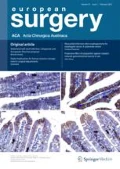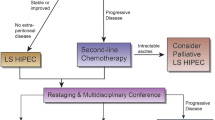Summary
Background
Intraoperative hyperthermic chemotherapy (HIPEC) is increasingly used in combination with cytoreductive surgery for the treatment of peritoneal carcinomatosis. The potential survival benefit of adjuvant HIPEC after curative gastrectomy has not been conclusively demonstrated. We describe a newly developed closed system for HIPEC and report the preliminary results of a pilot study.
Methods
Patients with locally advanced gastric carcinoma at a high risk for peritoneal recurrence were identified from a prospectively collected database. Laparoscopic total or subtotal gastrectomy combined with standard D2 lymphadenectomy was performed. Immediately after resection and 15 min before HIPEC treatment, intravenous induction chemotherapy with folinic acid and 5‑fluorouracil was administered. A closed-system HIPEC with turbulent-flow circuit (Combat PRS™, Peritoneum Recirculation System, Galmaz Biotech, Madrid, Spain) was used to perfuse the peritoneal cavity with a solution of oxaliplatin and glucose during 60 min. After washout of the peritoneal cavity and re-establishment of pneumoperitoneum, a Roux-en-Y esophagojejunostomy or gastrojejunostomy was performed.
Results
Between June 2017 and February 2018, 6 patients were treated according to this protocol. No major postoperative complications occurred. There were no intra- or postoperative complications related to the HIPEC procedure. All patients are alive and disease-free at 3–11 months of follow-up.
Conclusions
The preliminary results of this pilot study indicate the safety and feasibility of the closed HIPEC system with CO2 recirculation in selected patients undergoing laparoscopic total or subtotal gastrectomy for locally advanced gastric carcinoma.









Similar content being viewed by others
References
Yoo CH, Noh SH, Shin DW, Choi SH, Min JS. Recurrence following curative resection for gastric carcinoma. Br J Surg. 2000;87(2):236–42.
Ikoma N, Chen HC, Wang X, Blum M, Estrella JS, Fournier K, et al. Patterns of initial recurrence in gastric adenocarcinoma in the era of preoperative therapy. Ann Surg Oncol. 2017;24(9):2679–87.
Lee JH, Chang KK, Yoon C, Tang LH, Strong VE, Yoon SS. Lauren histologic type is the most important factor associated with pattern of recurrence following resection of gastric adenocarcinoma. Ann Surg. 2018;267(1):105–13.
Wu CW, Lo SS, Shen KH, Hsieh MC, Chen JH, Chiang JH, et al. Incidence and factors associated with recurrence patterns after intended curative surgery for gastric cancer. World J Surg. 2003;27(2):153–8.
De Andrade JP, Mezhir JJ. The critical role of peritoneal cytology in the staging of gastric cancer: an evidence-based review. J Surg Oncol. 2014;110:291–7.
Marutsuka T, Shimada S, Shiomori K, Hayashi N, Yagi Y, Yamane T, et al. Mechanisms of peritoneal metastasis after operation for non-serosa-invasive gastric carcinoma: an ultrarapid detection system for intraperitoneal free cancer cells and a prophylactic strategy for peritoneal metastasis. Clin Cancer Res. 2003;9(2):678–85.
Piessen G, Messager M, Leteurtre E, Jean-Pierre T, Mariette C. Signet ring cell histology is an independent predictor of poor prognosis in gastric adenocarcinoma regardless of tumoral clinical presentation. Ann Surg. 2009;250(6):878–87.
Kelsen DP. Adjuvant and neoadjuvant therapy for gastric cancer. Semin Oncol. 1996;23(3):379–89.
Huo YR, Richards A, Liauw W, Morris DL. Hyperthermic intraperitoneal chemotherapy (HIPEC) and cytoreductive surgery (CRS) in ovarian cancer: a systematic review and meta-analysis. Eur J Surg Oncol. 2015;41(12):1578–89.
Mirnezami R, Moran BJ, Harvey K, Cecil T, Chandrakumaran K, Carr N, et al. Cytoreductive surgery and intraperitoneal chemotherapy for colorectal peritoneal metastases. World J Gastroenterol. 2014;20(38):14018–32.
Montori G, Coccolini F, Ceresoli M, Catena F, Colaianni N, Poletti E, et al. The treatment of peritoneal carcinomatosis in advanced gastric cancer: state of the art. Int J Surg Oncol. 2014;2014:1–7.
Graziosi L, Mencarelli A, Renga B, Santorelli C, Cantarella F, Bugiantella W, et al. Gene expression changes induced by HIPEC in a murine model of gastric cancer. In Vivo (Brooklyn). 2012;26:39–45.
Feingold PL, Kwong MLM, Devis JL, Rudloff U. Adjuvant intraperitoneal chemotherapy for the treatment of gastric cancer at risk for peritoneal carcinomatosis: a systematic review. J Surg Oncol. 2017;115:192–201.
Roviello F, Caruso S, Neri A, Marrelli D. Treatment and prevention of peritoneal carcinomatosis from gastric cancer by cytoreductive surgery and hyperthermic intraperitoneal chemotherapy: overview and rationale. Eur J Surg Oncol. 2013;39(12):1309–16.
Glehen O, Passot G, Villeneuve L, Vaudoyer D, Bin-Dorel S, Boschetti G, et al. GASTRICHIP: D2 resection and hyperthermic intraperitoneal chemotherapy in locally advanced gastric carcinoma: a randomized and multicenter phase III study. BMC Cancer. 2014;14:183.
Glehen O, Cotte E, Kusamura S, Deraco M, Baratti D, Passot G, et al. Hyperthermic intraperitoneal chemotherapy: nomenclature and modalities of perfusion. J Surg Oncol. 2008;98(4):242–6.
Sugarbaker PH, Van der Speeten K. Surgical technology and pharmacology of hyperthermic perioperative chemotherapy. J Gastrointest Oncol. 2016;7:29–44.
Rodriguez Silva C, Moreno Ruiz FJ, Bellido Estevez I, Carrasco Campos J, Titos Garcia A, Ruiz Lopez M, et al. Are there intra-operative hemodynamic differences between the Coliseum and closed HIPEC techniques in the treatment of peritoneal metastasis? A retrospective cohort study. World J Surg Oncol. 2017;15(1):51.
Sanchez-Garcia S, Padilla-Valverde D, Villarejo-Campos P, Martin-Fernandez J, Garcia-Rojo M, Rodriguez-Martinez M. Experimental development of an intra-abdominal chemohyperthermia model using a closed abdomen technique and a PRS-1.0 combat CO2 recirculation system. Surgery. 2014;155(4):719–25.
Pascual-Ramirez J, Sanchez Garcia S, Gonzalez Ruiz de la Herran F, Villarejo Campos P, Lopez de la Manzanara Cano C, Haya Palazuelo J, et al. Security and efficiency of a closed-system, turbulent-flow circuit for hyperthermic intraperitoneal chemotherapy after cytoreductive ovarian surgery: perioperative outputs. Arch Gynecol Obstet. 2014;290(1):121–9.
Sanchez-Garcia S, Padilla-Valverde D, Villarejo-Campos P, Garcia-Santos EP, Martin-Fernandez J. Hyperthermic chemotherapy intra-abdominal laparoscopic approach: development of a laparoscopic model using CO2 recirculation system and clinical translation in peritoneal carcinomatosis. Int J Hyperthermia. 2017;33(6):684–9.
Badgwell B, Blum M, Das P, Estrella J, Wang X, Ho L, Fournier K, Royal R, Mansfield P, Ajani J. Phase II trial of laparoscopic hyperthermic intraperitoneal chemoperfusion for peritoneal carcinomatosis or positive peritoneal cytology in patients with gastric adenocarcinoma. Ann Surg Oncol. 2017;24:3338–44.
Author information
Authors and Affiliations
Corresponding author
Ethics declarations
Conflict of interest
D. Bernardi, E. Asti, M. Punturieri, A. Luporini, and L. Bonavina declare that they have no competing interests.
Ethical standards
All procedures followed were in accordance with the ethical standards of the responsible committee on human experimentation (institutional and national) and with the Helsinki Declaration of 1975, as revised in 2008. Informed consent was obtained from all individual participants included in the study.
Rights and permissions
About this article
Cite this article
Bernardi, D., Asti, E., Punturieri, M. et al. Laparoscopic gastrectomy and adjuvant hyperthermic intraperitoneal chemotherapy (HIPEC) using a closed system with turbulent-flow circuit: technical aspects and preliminary results of a pilot study. Eur Surg 50, 209–214 (2018). https://doi.org/10.1007/s10353-018-0538-9
Received:
Accepted:
Published:
Issue Date:
DOI: https://doi.org/10.1007/s10353-018-0538-9




